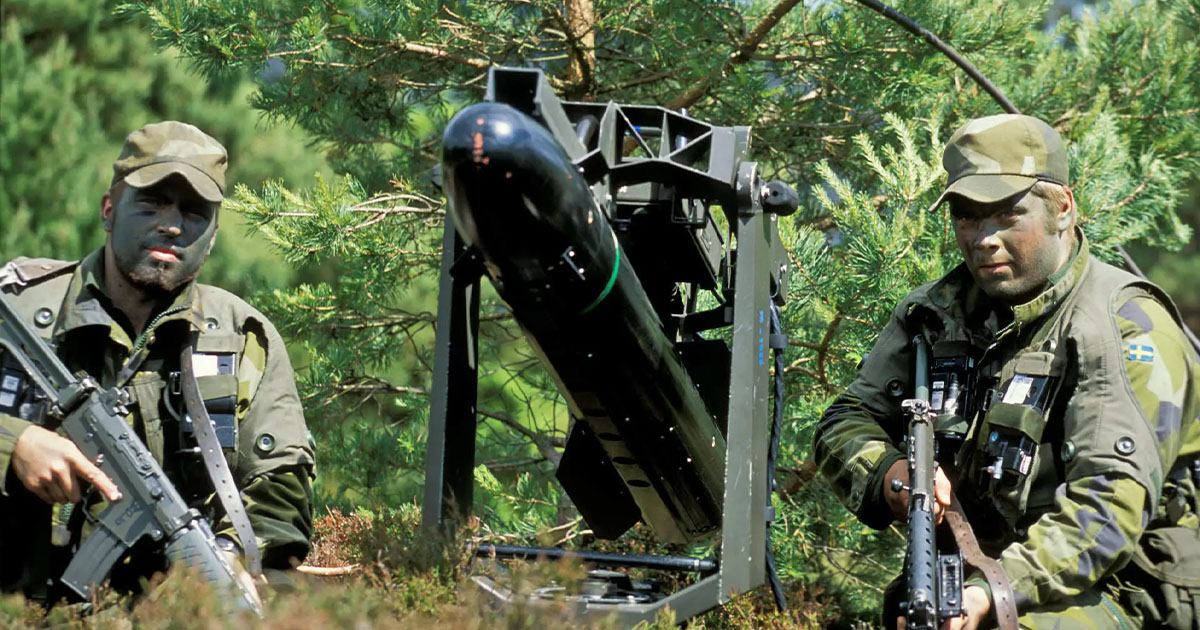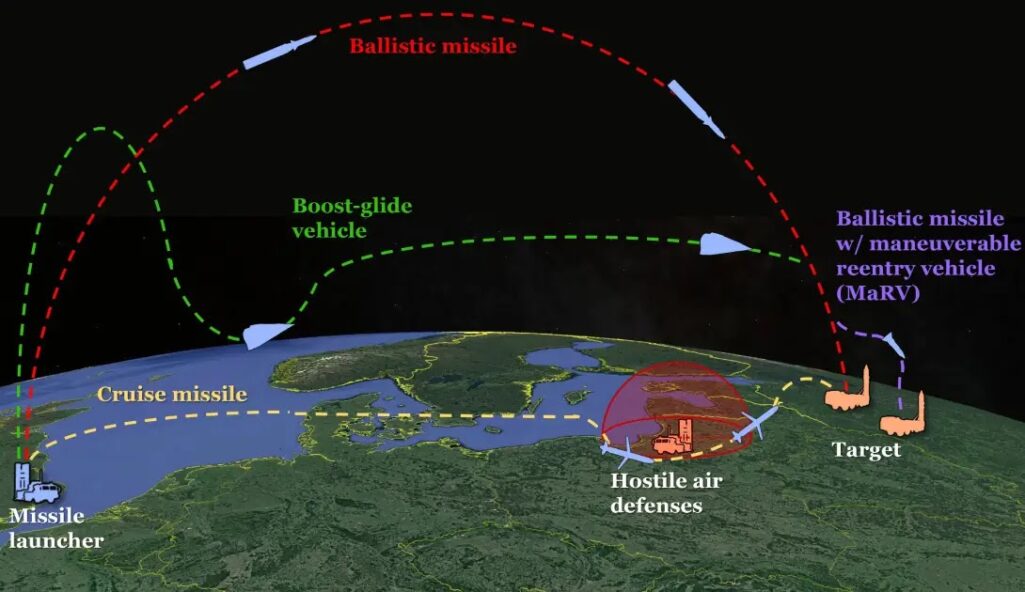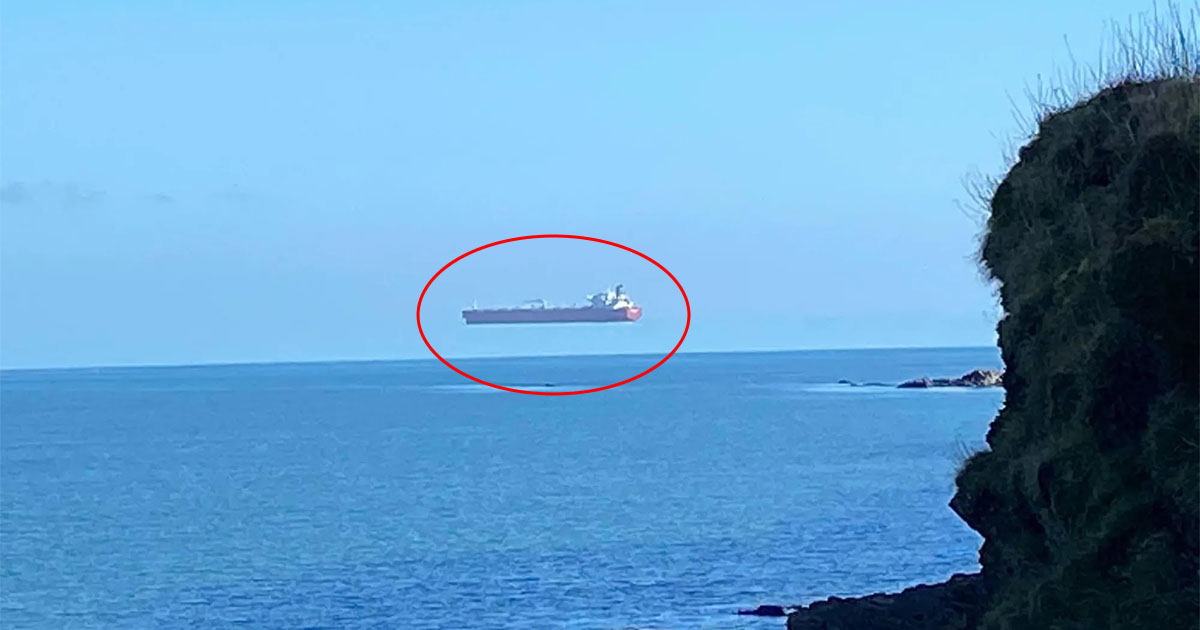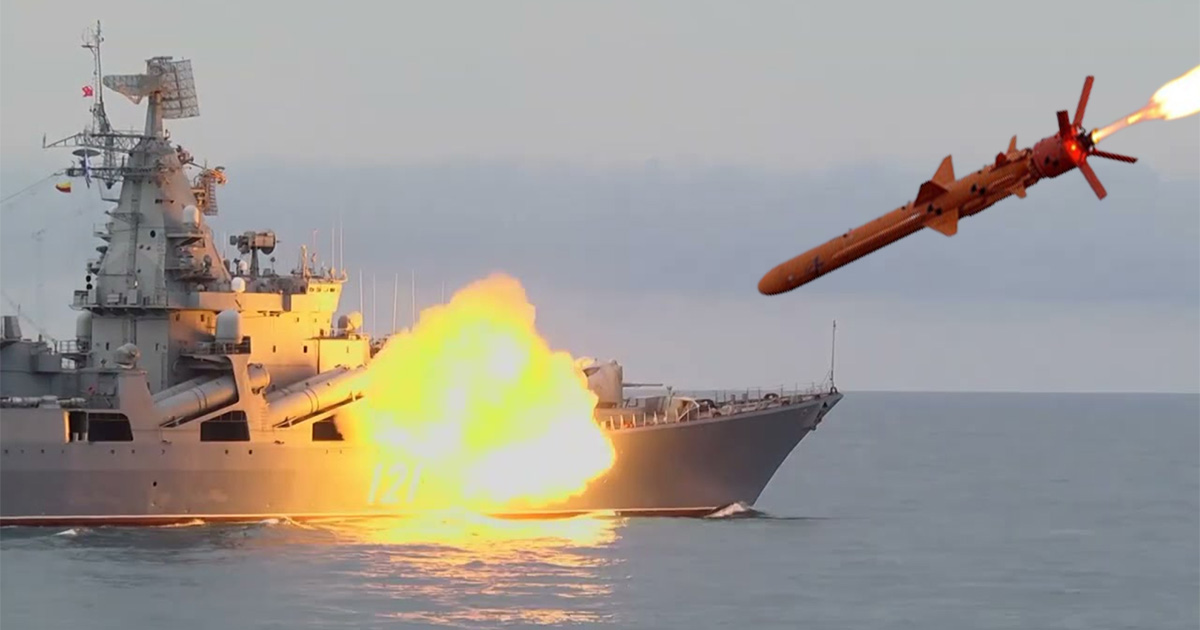
On 14th April 2022, Ukrainian officials and the US Department of Defense stated that Moskva was attacked by two Ukrainian anti-ship missiles called Neptune. The Russian Navy tried to save the ship, but they couldn’t, and the ship sank with more than 400 members of the ship crew.
This isn’t normal news that you could normally read and continue. This is different from any other news you read due to two reasons:
- Moskva is the largest warship that sunk in a battle since the WWII!
- Moskva is the flagship of the Russian Black Sea Fleet!
- Neptune anti-ship missiles are Ukrainian-made and not sent by the NATO or European countries!
How did the Neptune missiles hit the Moskva ship without being intercepted? Moskva is considered one of the greatest Russian ships; what options does this ship have to counter any threat? And what are the chances of the Neptune missile passing these defenses?
Moskva – The Russian Cruiser
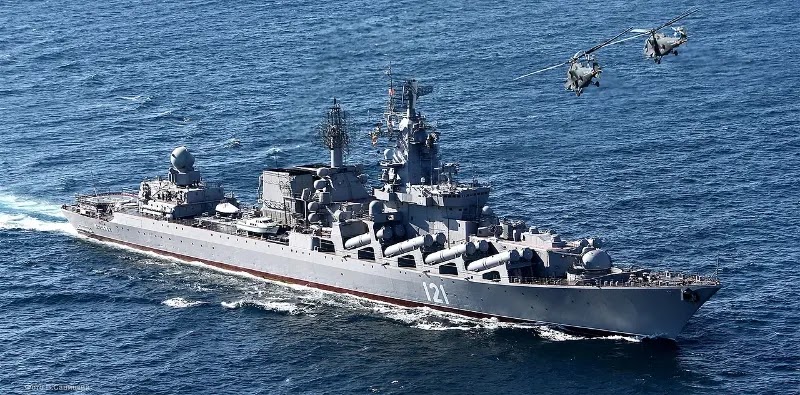
Moskva was a Russian Navy guided-missile cruiser. It was the flagship of the Project 1164 Atlant class and was named after the Russian capital Moscow.
She served as the flagship of the Russian Black Sea Fleet during the Russian invasion of Ukraine in 2022, and she played an important role in the naval assault. The cruiser had previously served in military operations in Georgia (2008), Crimea (2014), and Syria (2015).
It was first launched in 1979 during the Soviet period and was named Slava. It belongs to the Slava-class cruiser family. There are 3 Slava-class cruisers in the Russian Navy. One in the Pacific Ocean called Varyag, one in the Arctic Ocean called Marshal Ustinov, and lastly was Moskva in the Black Sea.
It was named Moskva in 1996. It was considered the most powerful ship in the region of the Black Sea. Moskva got maintenance and repairs in 2020, and it was scheduled to be in service up until 2040.
Moskva Specs
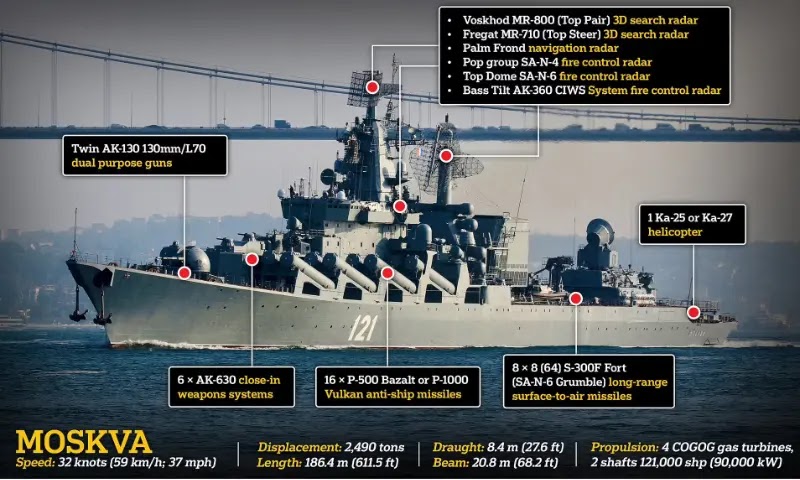
Moskva is a huge ship. It is 186.4 m (611 ft 7 in) long, 20.8 m (68 ft 3 in) wide (beam) and 8.4 m (27 ft 7 in) draft (depth underwater). It displaces 12,490 tons of seawater when it moves!
Moskva is powered by 4 massive gas turbine engines. A clutch system handles each turbine, and the total output produced is roughly 121,000 shaft horsepower delivered to 2 x shafts:
- Engine Power: 121,000 shp (90,000 kW)
- Speed: 32 knots (59 km/h, 37 mph)
- Range: 19,000 km (12,000 mile) at 16 knots (30 km/h, 18 mph)
Moskva can have approximately 476-529 crew members.
Moskva Radar Systems
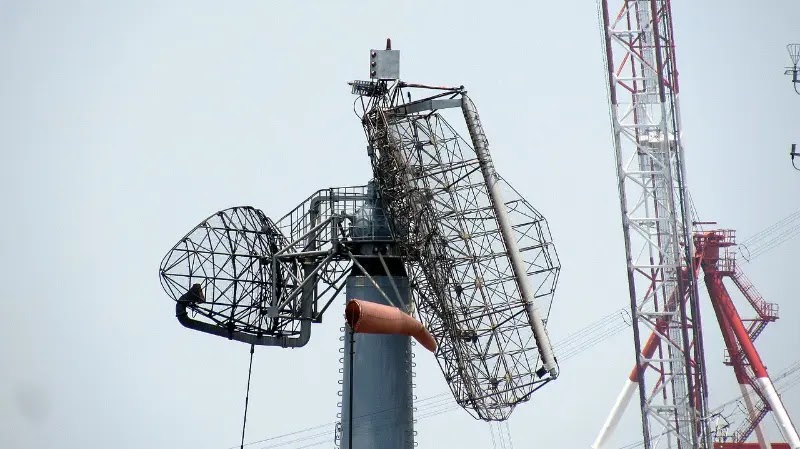
Voskhod/Top Pair’s MR-800 series 3D long-range search radar provides the Moskva with an advanced “all-seeing” digital set of sensors and processing capabilities. As an added measure of defense against approaching aircraft, the Fregat MR-710 3D air search radar is employed.
Palm Frond suite is used as a navigation radar. Moskva has multiple fire control radar systems:
- Pop group SA-N-4 fire control radar: This system is used to control 9K33 Osa missiles.

- Top Dome SA-N-6 fire control radar: This system is used to control the S-300 surface-to-air missiles.

- Bass Tilt AK-360 CIWS System fire control radar: This system is used to control AK-630 missiles.
- Bull horn MF hull-mounted sonar.
Moskva Anti-Missiles Systems

Moskva has various defensive missiles systems, including long-range and low-range, targeting both aerial threats and sea threats:

P-500 Bazalt or P-1000 Vulkan: Moskva has 16 of these missiles. They are surface-to-surface (from Moskva to other ships or land targets) supersonic cruise missiles. They had a range of 550 km and a maximum speed of Mach 3+.
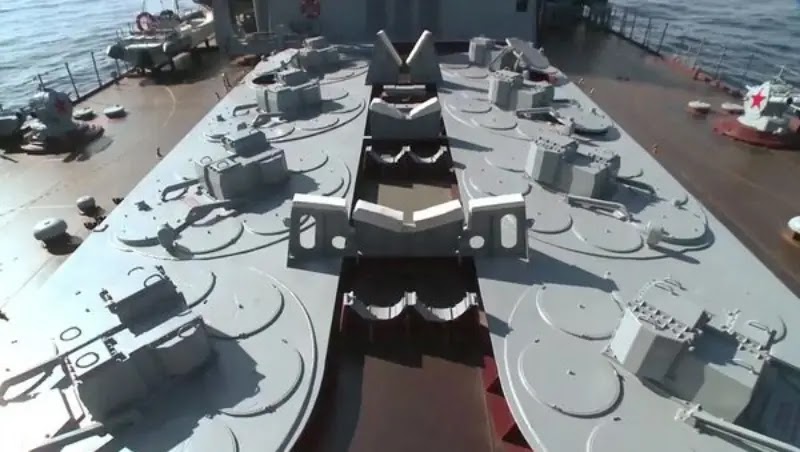
S-300F: Moskva has 64 S-300F missiles, which are long-range surface-to-air missiles (from Moskva to aircraft or missiles). These missiles have a range of 7–90 km (4.3–56 miles), a maximum speed of Mach 4, and an altitude of 25–25,000 m (82–82,021 ft).

9K33 Osa (SA-8): Moskva has 40 9K33 Osa missiles, which are low-altitude, short-range tactical surface-to-air missiles. They are used mainly against aircraft (mostly low flying) and also against anti-ship missiles. They have a range of 30 km (19 miles) and a maximum speed of 80 km/h (50 mph).
Moskva also has multiple guns and mortars:
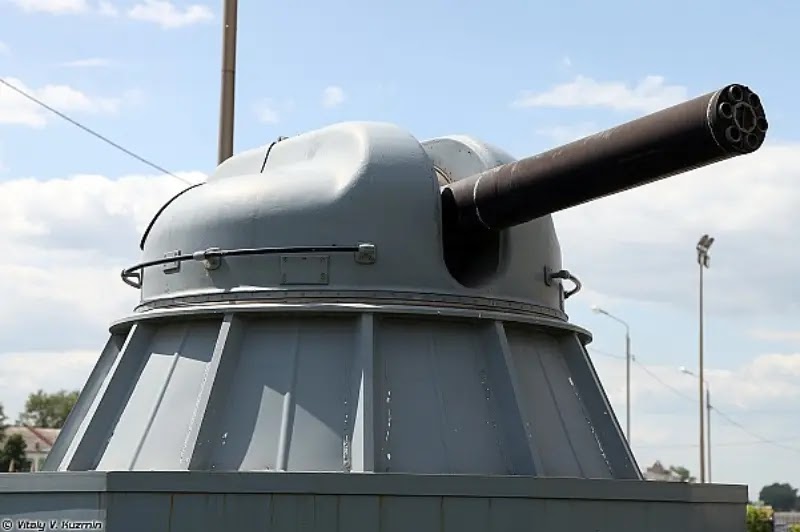
- 1 × twin AK-130 130 mm/L70 dual-purpose guns
- 6 × AK-630 close-in weapons systems
- 2 × RBU-6000 anti-submarine mortars
- 10 × (2 quin) 533 mm torpedo tubes
Neptune Missiles
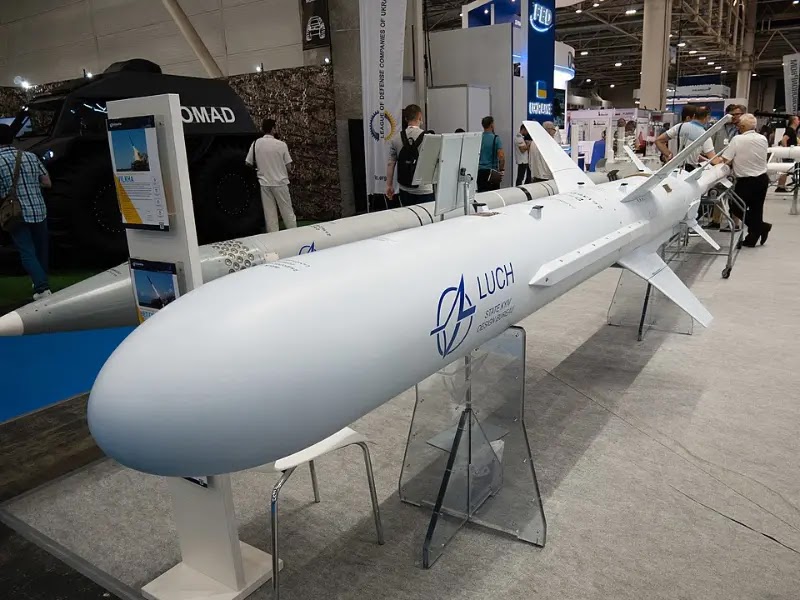
Neptune missiles, known as R-360 Neptune, are Ukrainian anti-ship cruise missiles. Its design is based on the old Soviet Kh-35 anti-ship missile but with many improvements.
It was first revealed in 2015 at Kyiv and entered the service in 2021. The missile was tested multiple times from 2016 to 2019, but its first practical use was on 13th April 2022, targeting the Moskva ship.
It was designed by the Luch Design Bureau, which started the development of the R-360 Neptune cruise missile in 2014.
The Neptune RK-360 MC division consists of the following:

- 6 unified USPU-360 launchers: USPU-360 is a truck-based mobile launcher that each one of them could have 4 Neptune missiles ready to fire.
- 6 TZM-360 and 6 TM-360 vehicles: These are transport vehicles, and each one of them could carry 4 Neptune missiles.
- RCP-360: It is a mobile command and control vehicle.
This system is designed to operate 25 km (16 miles) away from the coastline.
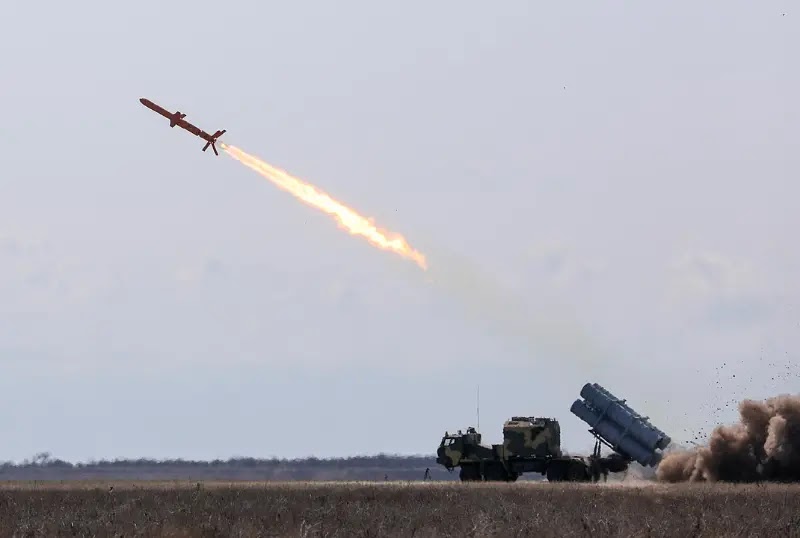
Neptune Test launch, 2019
Neptune Specs:
- Missile range: From 7 to 280 km
- Distance from coastline: Not more than 25 km
- Missile weight: 870 kg
- Warhead weight: 150 kg
- Missile speed: 900 km/h
How did Neptune pass through Moskva Defenses?
Now here comes the million-dollar question, how could the Newly developed missile by Ukraine pass through all the powerful and advanced defensive radar-guided systems of the Moskva?
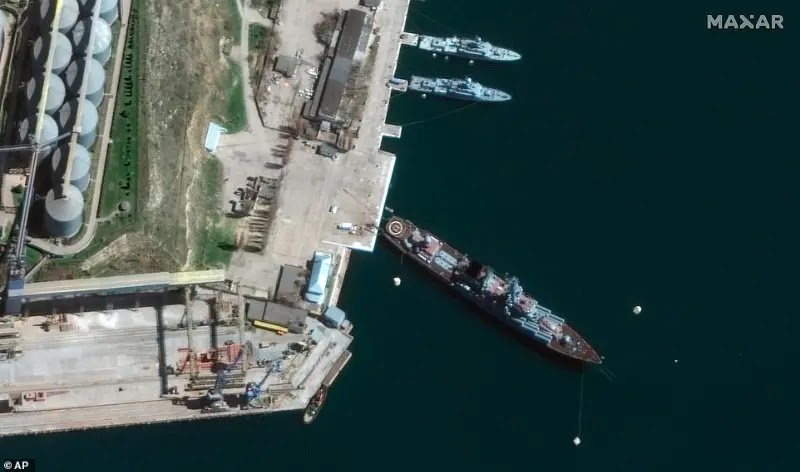
Moskva left the Sevastopol naval base in the Crimean peninsula to participate in the Russian Ukrainian war. The ship was the leader of the famous attack on Snake Island.
The last clear satellite picture of Moskva was on 10th April, near the port of Sevastopol.

Ironically, this ship is supposed to help protect the port and the other Russian ships!
A synthetic aperture radar picture captured on 13th April shows a ship matching Moskva’s size, about 150 km south of Odessa. Which is within the range of the Neptune missiles (280 km) that were fired from Odessa.

There are several hypotheses describing how did the Neptune missiles pass the Moskva defenses. And that is what we will try to discuss together and try to find the most convincing one of them.
Bayraktar Distraction
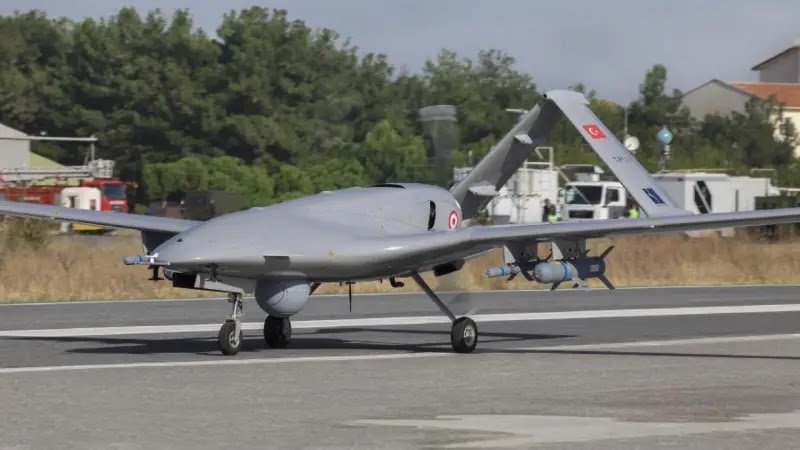
Ukrainian officials say that the Moskva was distracted by the Bayraktar drone before the Neptune missiles hit it. The drone was used to turn the radar systems to one side of the ship, and the Neptune missiles attacked from the other side.
This might seems illogical, but it could have helped in passing the Moskva defenses. Moskva has multiple radar detection systems, and such distraction shouldn’t be enough to make it vulnerable to missiles.
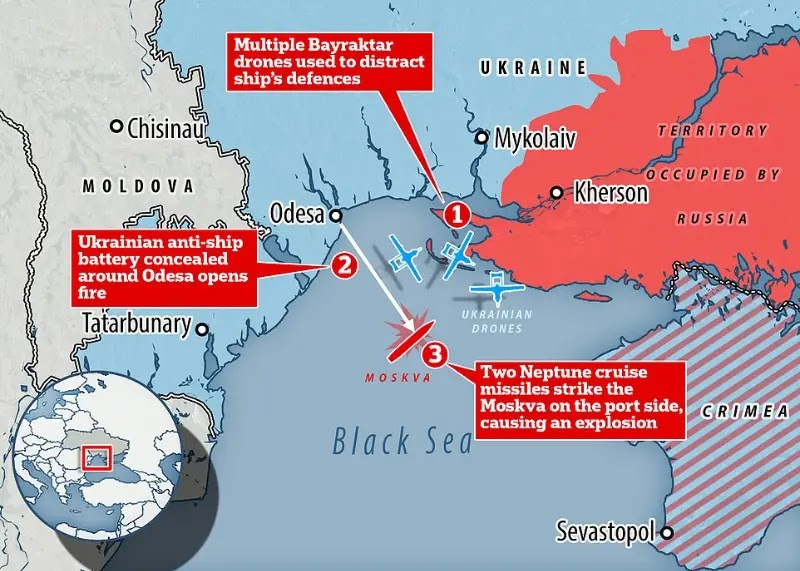
Voskhod MR-800 and Fregat MR-710 are both 360 degrees search radars that can detect enemies in all directions. However, as a search radars, they are considered less accurate than the fire control or target radars.
The most important radar is the Top Dome SA-N-6 fire control radar that is used to target the S-300F missiles. These are the missiles that the Moskva relies on mostly to target missiles and air threats. This radar is just 180 degrees and might be distracted by the drone.
How did the Russians not see the incoming Neptunes? The Moskva has/had a single main air defence radar – a 3P41 Volna phased array to guide S300 missiles. Problem is, it only has a 180 degree field of vision. /11 pic.twitter.com/81I8aBOJon
— ChrisO (@ChrisO_wiki) April 14, 2022
It could also be distracted by multiple Bayraktar drones, making the radar systems even suffer more. This idea is somehow logical. However, if the Top Dome radar that is used to fire the S-300F missiles is distracted, there are still the 9K33 Osa (SA-8) and the six AK-630 guns available.
Storm Distraction
It was stormy on that day. Waves, rain, storms and any weather conditions might have caused uncertainty for the radar systems on the Moskva. Multiple analysts have said at this point that radars will not be able to clearly distinguish between the high sea wavelengths and low-altitude flying missiles. And if you don’t know how Neptune flies and why this gives the missile a great advantage against the enemy ship, you should read the next coming paragraphs.
One YouTube channel has done an interesting simulation for this case, using the Moskva as a target and launching Neptune missiles at it. The ship was able to capture the missiles multiple times.
But when he changed the weather conditions to stormy and rainy, this was the surprise. The ship was not able to detect the missiles early and only engaged the Ak-630 turrets just before the missile reached. This was not enough time, and the missile was able to hit the Moskva.
Watch the simulation below:
Low Altitude

The Neptune missiles are fired from a truck on the ground. After its initial launch, the missile starts lowering down over the seawater to an altitude of about 10-15 m. It continues lowering down until reaching just 3-10 m above the wave crest before reaching its target.
This very low altitude makes it very difficult for the radars to detect it.
I don’t know if this really matters, but what I have noticed is that the S-300F defensive missiles have a minimum altitude of 20-25 m, making it impossible to hit Neptune flying at that low altitude.
This takes us to the second missiles system, which is also considered as a low-altitude missile. The 9K33 Osa (SA-8) also has a minimum altitude of 25 m, making it useless against this over-wave-crest low-altitude Neptune missile.
Only the AK-630 is going to engage with the approaching missile. The AK-630 has an engaging range for inbound missiles of about 1.5km. And since the Neptune missile is flying at a speed of 900 km/h, this means that the AK-630 turrets will have just 6 seconds to respond (do the math).
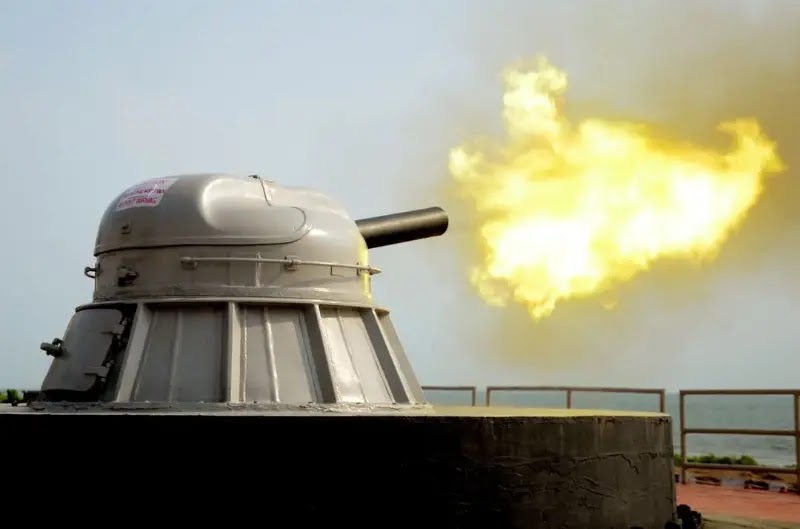
Even though the Moskva has 6 AK-630 turrets, and at least two or maybe even three will be engaged in attacking the incoming missile, this might not be enough with just 6 seconds.
Again, this is just my own analysis of why Neptune could have passed the two most powerful defensive systems on Moskva. It could be true or false. Please consider sharing your thoughts with us regarding this point in the below comments section. Do you think that this low altitude has given Neptune the advantage to pass Moskva defenses?
Conclusion
In the end, all these are just analyses that might be true or false. Until official Russian sources provide details on how the Neptune missile destroyed the Moskva and caused it to sink, I think these are the most logical reasons that caused the Moskva’s disaster.
What should also be considered is that what caused this complete destruction of the ship was not the Neptune missiles but the P-500 Bazalt missiles available on the cruise. These missiles look like they are the most obvious target for the missiles.
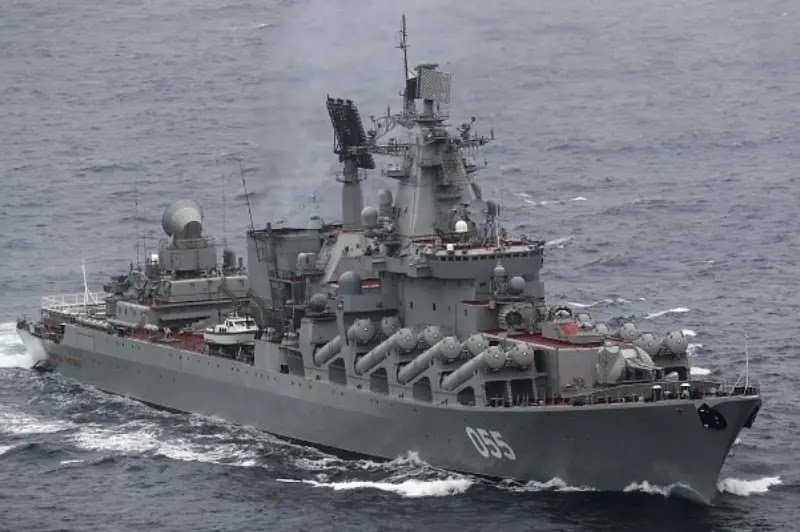
Hitting these missiles will help in destructing the ship even more and cause more fire and explosions.
What do you think was the main reason that caused the Moskva defensive failure?


